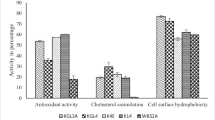Abstract
This study was carried out to find the possibility of fermenting yam (Dioscorea opposita Thunb.) with Lactobacillus acidophilus and the protective role on stomach lesion of rats. The solutions of raw and extracted yam used were 2 and 6%, and they were fermented by L. acidophilus at 37°C for 0, 12, 24, and 36 h. At intervals (0, 12, 24, and 36 h), viscosity, titratable acidity (TA), allantoin, and diosgenin were examined. In the results, it was observed the most desirable data at 12 h with 6% fermented raw yam (FRY) without any change in the content of allantoin and diosgenin. In the animal study by rats (Sprague-Dawley), the inhibition ratios on gastric lesion were 53.41% in FRY. Based on these data, it confirmed that raw yam powder fermented by L. acidophilus would be a functional food with the supplement of viable cells and nutraceutical component of allantoin and diosgenin.
Similar content being viewed by others
References
Shah NP. Functional foods from probiotics and prebiotics. Food Technol. -Chicago 55: 46–53 (2001)
Lee YK, Salminen S. The coming of age of probiotics. Trends Food Sci. Tech. 6: 241–245 (1995)
Gomes AMP, Malcata FX. Bifidobacterium spp. and Lactobacillus acidophilus: Biological, biochemical, technological, and therapeutical properties relevant for use as probiotics. Trends Food Sci. Tech. 10: 139–157 (1999)
Gilliland SE, Speck ML. Enumeration and identity of lactobacilli in dietary products. J. Food Protect. 40: 760–762 (1977)
Achi OK, Akubor PI. Microbiological characterization of yam fermentation for ‘Elubo’ (yam flour) production. World J. Microb. Biot. 16: 3–7 (2000)
Park JH, Ahn J, Kwak HS. Physicochemical properties of Dioscorea opposita Thunb. solution fermented by Lactobacillus bulgaricus. Korean J. Food Sci. An. 30: 773–779 (2010)
Babajide JM, Oyewole OB, Henshaw FO, Babajide SO, Olasantan FO. Effect of local preservatives on quality of traditional dry yam slices ‘Gbodo’ and its products. World J. Agric. Sci. 2: 267–273 (2006)
Kouassi B, Diopoh J, Leroy Y, Fournet B. Soluble sugars from yam and changes during tuber storage. Phytochemistry 29: 1069–1072 (1990)
Fu YC, Ferng LHA, Huang PY. Quantitative analysis of allantoin and allantoic acid in yam tuber, mucilage skin, and bulbil of the Dioscorea species. Food Chem. 94: 541–549 (2006)
SAS Institute, Inc. SAS User’s Guide. Statistical Analysis Systems Institute, Cary, NC, USA (2002)
Wanasundara JPD, Ravindran G. Nutritional assessment of yam (Dioscorea alata) tubers. Plant Food. Hum. Nutr. 46: 33–39 (1994)
Yoon KY, Woodams EE, Hang YD. Probiotication of tomato juice by lactic acid bacteria. J. Microbiol. 42: 315–318 (2004)
Chang KJ, Park BJ, Paek JH, Kim SL, Park CH. Tuber enlargement and chemical components of yams (Dioscorea opposita Thunb.). Korean J. Plant Res. 18: 161–168 (2005)
Shin KO, Jeon JR, Lee JS, Kim JY, Lee CH, Kim SCD, Yu Y, Nam DH. Lactic acid fermentation of Chinese yam (Dioscorea batatas Decne) flour and its pharmaceutical effect on gastrointestinal function in rat model. Biotechol. Bioproc. E. 11: 240–244 (2006)
Misaki A, Ito T, Harada T. Constitutional studies on the mucilage of “yamanoimo”, Dioscorea batatas Decne, forma Tsukune: Isolation and structure of a mannan. Agr. Biol. Chem. Tokyo 36: 761–71 (1972)
Tsai SS, Tai FJ. Studies on the mucilage from tuber of yam (Dioscorea alata Linn.) I. Isolation and purification of the mucilage. J. Chin. Agr. Chem. Soc. 22: 88–94 (1984)
Lodish H, Matsudaira P, Berk A, Zipursky SL, Scott MP. Molecular cell biology. Vol. 1, pp. 1092–1093. In: Cell Growth and Development. 6th ed. Freeman WH & Co. and Chinese Union Medical Univ., Joint Publishing. New York, NY, USA (2007)
Fsu FL, Lin YH, Lee MH, Lin CL, Hou WC. Both dioscorin, the tuber storage protein of yam (Dioscorea alata cv. Tainong No. 1), and its peptic hydrolysates exhibited angiotensin converting enzyme inhibitory activities. J. Agr. Food Chem. 50: 6109–6113 (2002)
Hsu CC, Huang YC, Yin MC, Lin SJ. Effect of yam (Dioscorea alata compared to Dioscorea japonica) on gastrointestinal function and antioxidant activity in mice. J. Food Sci. 71: 513–516 (2006)
Jeon JR, Lee JS, Lee CH, Kim JY, Kim SD, Nam DH. Effect of ethanol extract of dried Chinese yam (Dioscorea batatas) flour containing dioscin on gastrointestinal function in rat model. Arch. Pharm. Res. 29: 348–353 (2006)
Author information
Authors and Affiliations
Corresponding author
Rights and permissions
About this article
Cite this article
Lee, S.Y., Ganesan, P., Ahn, J. et al. Lactobacillus acidophilus fermented yam (Dioscorea opposita Thunb.) and its preventive effects on gastric lesion. Food Sci Biotechnol 20, 927–932 (2011). https://doi.org/10.1007/s10068-011-0128-0
Received:
Revised:
Accepted:
Published:
Issue Date:
DOI: https://doi.org/10.1007/s10068-011-0128-0




